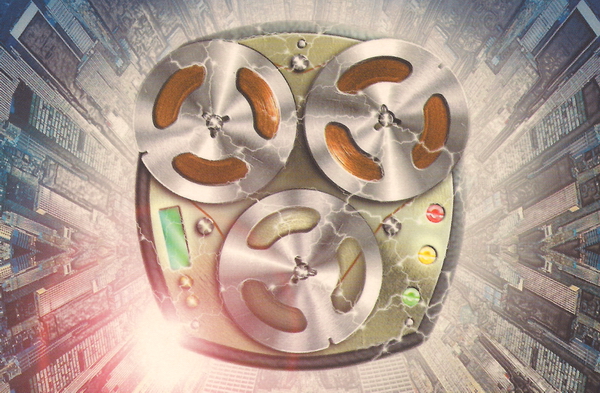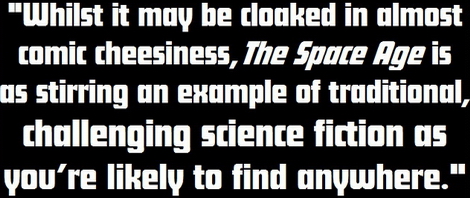|
| |
|
STORY PLACEMENT THIS STORY TAKES PLACE BETWEEN THE NOVELS "COLDHEART" AND "THE BANQUO LEGACY."
WRITTEN BY STEVE LYONS
RECOMMENDED PURCHASE OFFICIAL BBC 'EIGHTH DOCTOR' PAPERBACK (ISBN 0-563-53800-7) RELEASED IN MAY 2000.
BLURB This is the city: a technological paradise built by an advanced race.
here were enlightened and contented. They travelled in bubble- topped saucer cars or in anti-gravity tubes. Obedient robots tended to their every whim. Disease, war, famine and pollution had been eradicated, and personal rocket ships brought the solar system within reach, ALLOWING The people of the city TO befriend Venusians
and Martians alike. CITY'S buildings are constructed from a TYPE OF metal that will never tarnish. It will stand forever as a monument to the Achievements of the
human race. year is 2000AD.
This is your future. Age. |
|
|
The Space Age MAY 2000
Steve Lyons’ Space Age is a wonderfully packaged little book. The quirky title inevitably provokes a certain image in the mind - a Jetsons-like futurama where silver-clad citizens whiz about on jet packs all day, while their Flash Gordon-esque servo-robots take care of the domestic drudgery – which Black Sheep really pander to with their cover design and choice of blurb font. But inside the paperback lies a tale that defies expectation in just about every way, taking the reader’s perception of humanity’s comic book future, turning it sideways and shoving it somewhere where the sun doesn’t shine.
The Space Age wears its kookiness on its sleeve right from its opening line. “History is being remade constantly,” Lyons gently teases as his reader draws in a deep breath and prepares for another Interference-style onslaught. But within just a few pages – just a few paragraphs, even – it becomes clear that the author isn’t talking about the Web of Time, quantum offshoots or even good old-fashioned temporal paradoxes. He’s talking about people, their ordinary lives, the paucity of second chances that life generally offers and the futility of those that it does.
Lyons’ story concerns the fate of a group of humans abducted from 1965 by a gestalt entity known only as ‘the Maker’ and deposited in an enclosed city on an uninhabitable world in the early 31st century. As one would expect, this conflicting mob of young mods and rockers just assumed that they had been transported to a space age city in the year 2000, that the airless world beyond the city had been annihilated by nuclear war, and that the apparently benevolent Maker had put them in this city to set about repopulating the human race. But rather than enjoy their utopia, the mods and rockers soon split into their respective factions and began their own little war, which by the time the Doctor and his companions enter the fray is all but over, their formerly gleaming city now on the verge of ruin and collapse. It’s a certainly fascinating concept, and one that Lyons really milks for all its worth.
about this book is how it explores human psy- chology and society, and the relationship between the two. In juxtaposing the mund- ane and the fantastic, Lyons is able to high- light humanity’s most profound strengths and crippling weaknesses. Whilst it may be cloaked in almost comic cheesiness, at its best The Space Age is as stirring an example of traditional, challenging science fiction as you’re likely to find anywhere.
As a Doctor Who story though, The Space Age is clearly lacking is one in key area: threat. In this book the Doctor doesn’t have a monster or villain to fight – his opponent is humanity itself and its ineluctable propensity for self-destruction. There is often danger, of course, posed by both mods and rockers alike, and what’s more the whole narrative is set against the invisible ticking of a clock as the city creeps ever closer to total collapse. Even so, I’m sure that some would argue that The Space Age could do with a Selachian or two to give the Doctor a tangible foe to rally against.
For my part though, I enjoyed reading about the Doctor being faced with a slightly more abstract quandary. This story’s unique premise allows Lyons to really bring out the eighth Doctor’s humanity and romance, portraying him as a poetic hero in a vain battle with the future that only his walking dues ex machina of a companion can save him from.
Indeed, Lyons’ use of Compassion in The Space Age is quite innovative. As I read through the first half of the book, I had assumed that the Doctor’s living TARDIS would be sidelined throughout – the novel’s first scene depicts a Compassion that is apparently more TARDIS than human, just stood there inert waiting for her passengers to return from their saunter. However, as the storyline progresses we learn that Compassion is still very much human, and that her mind is actually occupied seeking out the Maker, whose presence she can sense. Ultimately it is Compassion who is able to determine the gestalt nature of the Maker, and thus realise its mistake, leading to Lyons’ poignant finale that sees the Maker offer the humans that it once kidnapped a choice: make your own future here in the city, or go back to 1965, your life rewound, your lessons unlearned.
The novel’s final passages are actually quite excruciating to read, as the humans that return to 1965 start to make all the same mistakes again before without even pausing for breath. But amongst the gloominess comes one note of cheer: Compassion’s communion with the Maker has finally taught her who and what she is, and she’s happy with her lot. Doctor, Fitz and all…
And so whilst The Space Age may lack the punch of the heavyweight eighth Doctor novels,
it compensates with a distinctive premise and superlative execution.
Anything capable of effectively drawing together elements from sources as
eclectic as Romeo & Juliet, West Side Story and Buck Rogers
would be worth a peep in any event, but laden as it is with pop psychology
and brutal sociology, The Space Age is one wonderfully packaged
little book that must be read.
|
|
|
Copyright © E.G. Wolverson 2010
E.G. Wolverson has asserted his right under the Copyright, Designs and Patents Act, 1988 to be identified as the author of this work. |
|
|
Unless otherwise stated, all images on this site are copyrighted to the BBC and are used solely for promotional purposes. ‘Doctor Who’ is copyright © by the BBC. No copyright infringement is intended. |
|

.jpg)
.jpg)

 What
stands out most
What
stands out most